Babies & pre-schoolers
Why does my baby need a hearing aid?
If your child has been identified as having a hearing loss the
correct hearing aid(s) are vital to the development of spoken
language and educational success. There are different models of
hearing aids available depending on the type/level of hearing
loss.
What is a behind the ear hearing aid?
This type of hearing aid is a small, wearable electronic device
designed to improve hearing by making some sounds louder and
improving speech clarity. The hearing aid sits behind the ear and
delivers amplified sound into the ear canal via a custom made
earmould. Your child's hearing aid(s) are selected and programmed
by an audiologist at the Children's Hearing Centre
according to the hearing test results to suit his/her hearing loss
for each ear. Your child's hearing levels will continually be
reassessed and changes to the programming made as required. Hearing
aid features will be activated/selected specifically for your child
depending on their age and hearing loss. The hearing aid(s)
provided are high quality, digital hearing aids. Hearing aids are
provided (on loan) free of charge to all children on the
NHS. Some hearing aids, depending on the model, are
rechargeable. The model selected for your child depends on their
level and type of hearing loss.
When should my child wear their hearing aid(s)?
It is essential that you work towards helping your child wear
their hearing aid(s) during all waking hours
(except for bathing and swimming). The hearing aid(s) will help
your child to hear speech sounds clearly. They need to hear lots of
clear speech to develop their own talking.
Babies naturally spend a lot of time exploring with their hands
and this includes their ears and hearing aid(s). If your child is
continually pulling out their hearing aids, firstly check that
there is no loudness discomfort and that the earmoulds are a good
fit. If they continue to pull them out it is advised to take a
consistent approach and put the aids back in every time they are
removed. This may take some patience and perseverance and feel
quite frustrating at times but try to remain positive and remember
that this is often just a phase. Once your child learns to
associate the hearing aids with improved hearing they are more
likely to want to wear them. If you feel you need additional help
or support with this please contact your audiologist or your
hearing support teacher.
Some helpful tips for keeping hearing aids in:
- Use double sided (toupee) tape to keep hearing aids in place
behind your baby's ears (provided in the hearing aid kit bag)
- Attach clothing clips to hearing aids. These clip onto the back
of your child's clothes so the hearing aids will not be lost if
they are pulled out (provided in the hearing aid kit bag).
- Distract your child e.g. with some hand held toys when you have
put the hearing aids back in.
- There are additional products available to purchase online to
help discourage aids being pulled out. These include: thin mesh
bonnets worn over the aids and head bands with pockets to help keep
aids in place
|
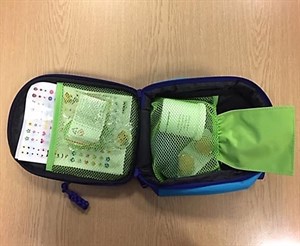
The hearing aid kit bag
|
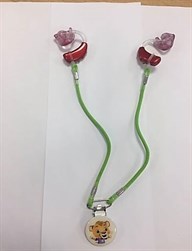
Clothing clips attached to
hearing aids
|
What is data logging?
Your child's hearing aid(s) have a data-logging facility. This
provides your audiologist with information on how long the
hearing aid(s) are worn and which settings are used. Data logging
assists in supporting optimal hearing aid use and benefit.
How can I help my child get the most from their hearing
aid(s)?
Hearing aids work optimally in quiet situations. Therefore,
whenever possible try to keep background noise to a minimum, for
example:
- switching the television/radio off if not being watched
- being aware of noise from household appliances such as washing
machines, vacuum cleaners etc.
- closing doors between rooms at home to try isolate sources of
noise where possible
- be aware that your child will find it more difficult to hear in
environments with poor acoustics e.g. places with hard surfaces
that result in higher levels of reverberation/unpleasant noise such
as play groups in church halls.
Will my child be upset by loud sounds?
Hearing aids have sophisticated digital technology which
constantly monitors the level of sound going into the microphones.
The aid will then automatically adjust the level of amplification
to ensure that the level of sound reaching your child's ear stays
within the comfortable hearing range. Some children, if feeling
unwell or particularly tired, may be less tolerant of noisy
situations and will try to remove the aids or become upset.
Giving your child some quiet time, or removing their aids for a
short period of time usually helps. If however you feel your child
is consistently showing signs of loudness discomfort (e.g.
excessive blinking and distress to loud sounds) then please contact
your audiologist or Hearing Support Teacher. It might be useful
trying one aid at a time to see if this alleviates any
possible loudness discomfort.
How do I know if the earmoulds are fitting well?
In order to ensure optimal performance, comfort and sound
quality from a hearing aid it is vital 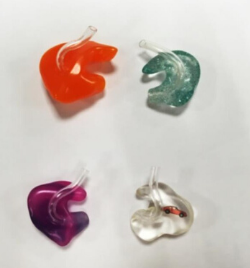 that Ithe
earmould fits well. Earmoulds are custom made for each child and
are available in many different colours/with picture inserts
(further examples of these are available to see at the Children's
Hearing Centre and on our website). Earmoulds can be made from
different types of materials (plastic or silicone). Some are very
soft and some are harder. They may also have a small hole through
them, called a vent. Features of the earmould are selected based on
the type and severity of your child's hearing loss.
that Ithe
earmould fits well. Earmoulds are custom made for each child and
are available in many different colours/with picture inserts
(further examples of these are available to see at the Children's
Hearing Centre and on our website). Earmoulds can be made from
different types of materials (plastic or silicone). Some are very
soft and some are harder. They may also have a small hole through
them, called a vent. Features of the earmould are selected based on
the type and severity of your child's hearing loss.
As your child grows you might notice the earmoulds becoming
loose, accompanied with acoustic feedback (a high pitch whistling
sound). This occurs when the amplified sound from the hearing aid
leaks out of the ear and reaches the microphone. The more powerful
the hearing aid, the more likely the chance of feedback occurring.
Feedback can be a sign that the earmould(s) are too small and new
ones are needed or that there is lots of wax in the ear
canal.
How do I get a new earmould for our child?
The shape of the ear is taken (an impression) by a qualified
audiologist. The ear is filled with a medical grade
putty-like material. This is allowed to set before being removed,
which takes just a few of minutes. The impression(s) are then sent
to a specialist company who make the earmould(s) and return them to
the Children's Hearing Centre. This process takes approximately 6
days. Impressions for new earmoulds need to be taken on a regular
basis as your child continues to grow.
Where and when can my child get impressions taken?
- The Children's Hearing Centre: an Earmould Clinic is held on
alternate Tuesdays and Wednesdays.
- Acorns Group at Elmfield House on Wednesday mornings
(babies and toddlers only- ears MUST be clear of wax)
- Your child's hearing aid review appointment at the Children's
Hearing Centre (ears MUST be clear of wax)
It is important that the ear canals are clear of wax for
impressions to be taken. At the earmould clinic a specialist nurse
is available to syringe your child's ears if necessary.
How is earwax managed?
Sodium Bicarbonate eardrops (provided in your 'hearing aid kit
bag' with instructions for use) can be used if your child is prone
to excessive wax. For some children, however, there may be a
medical reason why drops should not be used (e.g. grommets or
perforated eardrums).
Earmoulds need to be kept clean and the tubing free of wax. To
effectively clean the earmould:
How are earmould(s) cleaned?
- Remove the earmould from the hearing aid
- Wash it in warm soapy water
- Stubborn bits of wax may be removed carefully from the inside
of the tube with an unfolded paperclip /
pin.
- Dry the earmould thoroughly
- Reattach the earmould to the hearing aid (remember the
curve of the mould fits into the inside curve of the hearing
aid).
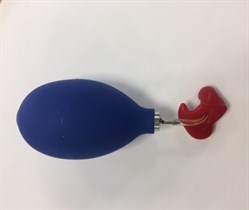
Additional moisture can be removed
using the earmould 'puffer' (provided in your hearing aid kit
bag).
What is an earhook?
This joins the hearing aid to the earmould and keeps the
hearing aid in place behind the ear. It should be replaced if it
becomes: discoloured, chewed, collapsed or loose. Please contact
the Children's Hearing Centre if a replacement is required.
Can the tubing be replaced?
The flexible, clear plastic tubing delivers amplified sounds to
the ear canal. After a few months, the tubing can go hard
and/or discoloured. It is important to change the tubing
regularly. (Spare tubing and instructions are provided in your
hearing aid kitbag). Please ask your audiologist or Hearing Support
Teacher for help if required with this. The NDCS have videos
regarding caring for your child's hearing aids including how to change the tubing.
How are replacement hearing aid batteries obtained?
Hearing aids require small batteries which are provided free by
the Children's Hearing Centre.
- The life of a battery is dependent on many factors such as
hearing aid type, how often the aid is used, at what volume etc. A
general guideline would be 7 - 15 days. For young children we
advise that the batteries get changed once a week on a set day
- Replacement batteries are available from the Children's Hearing
Centre by emailing, telephoning, or collection at an appointment/ a
pre- arranged time. Contact the department in advance of using the
last battery to allow for postage
- The batteries are activated by contact with air, therefore the
sticky tab should be removed just prior to use. Remove old battery
and insert new one as indicated on the side of the battery
compartment
- Some hearing aids have battery locks to make removal more
difficult for young children. The battery compartment must
not be forced open. Depending on the type of lockable battery door,
a tool will be supplied if necessary.
- Please dispose of old batteries carefully in your household
recycling orreturn them to the Children's Hearing Centre
for recycling. Batteries should not be disposed of in general
household waste (landfill)
- Spare and spent batteries should be kept well away from
children and pets as swallowing them is a very serious health
risk
- Always carry spare batteries, as hearing aid batteries can
suddenly die
How do I look after the hearing aid(s)?
- Keep out of reach of young children when not in
use. This is vital to remember because when they are not
in use and switched off the batteries can be accessed.
- Your child's hearing aid(s) need to be stored safely in the box
provided when they are not being worn.
- Hearing aids are very expensive and sophisticated devices so
please take great care of them.
How do I check the hearing aid is working well?
It is important to ensure the hearing aid is always working
correctly by carrying out regular maintenance checks:
- Switch the hearing aid on hold it in the palm of the hand. It
should "whistle" steadily. If it doesn't, replace the battery and
repeat.
- Ensure the earmould and tubing are not blocked with wax or
water droplets.
- Attach the hearing aid to a listening clip (provided in your
hearing aid kit bag) and talk softly to yourself and observe the
quality of sound. It should not sound distorted.
- Take the hearing aid off the listening clip and perform visual
checks for cracks in the casing. This can sometimes cause
feedback.
These are only basic checks. If your child complains or seems
less responsive than usual when wearing his/her hearing aid, it is
important to get the device thoroughly tested by an audiologist at
the Children's Hearing Centre.
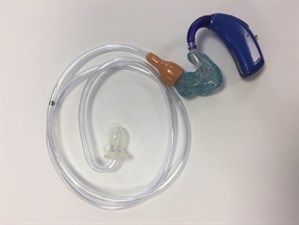
Listening clip attached to
earmould